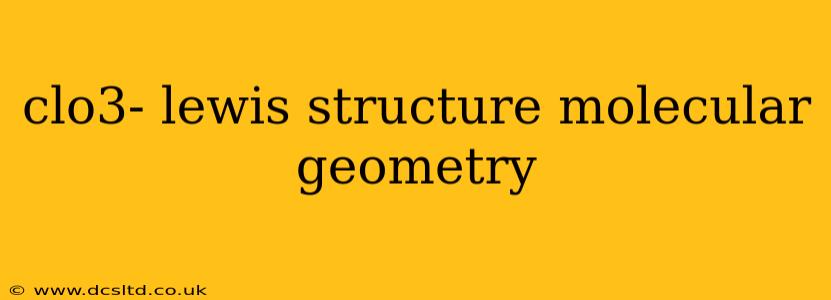Chlorate, with the chemical formula ClO₃⁻, is a polyatomic anion composed of one chlorine atom and three oxygen atoms. Understanding its Lewis structure is crucial to predicting its molecular geometry and properties. This article will delve into the intricacies of the ClO₃⁻ Lewis structure, explaining its formation, electron distribution, and resulting molecular geometry. We'll also address common questions surrounding this important chemical species.
How to Draw the ClO₃⁻ Lewis Structure
Drawing the Lewis structure involves several steps:
-
Count Valence Electrons: Chlorine has 7 valence electrons, and each oxygen atom has 6. Since it's an anion with a -1 charge, we add one more electron. The total is 7 + (3 x 6) + 1 = 26 valence electrons.
-
Central Atom: Chlorine, being less electronegative than oxygen, becomes the central atom.
-
Single Bonds: Connect the central chlorine atom to each oxygen atom with a single bond, using 6 electrons (3 bonds x 2 electrons/bond).
-
Octet Rule: Complete the octet (8 electrons) around each oxygen atom by adding lone pairs. This uses 18 electrons (6 electrons/oxygen x 3 oxygens).
-
Remaining Electrons: We have 26 - 6 - 18 = 2 electrons left. These are placed as a lone pair on the chlorine atom.
-
Formal Charges: To minimize formal charges, we can convert one lone pair on an oxygen atom into a double bond with the chlorine. This results in a more stable structure with lower formal charges. There are three possible resonance structures, each with one double bond to a different oxygen.
Therefore, the ClO₃⁻ Lewis structure showcases resonance, meaning the actual structure is a hybrid of these three contributing structures.
What is the Molecular Geometry of ClO₃⁻?
The molecular geometry of ClO₃⁻ is trigonal pyramidal. While the electron-pair geometry (considering all electron pairs, including bonding and lone pairs) is tetrahedral, the lone pair on the chlorine atom pushes the three oxygen atoms slightly closer together, resulting in a trigonal pyramidal shape. This is a crucial difference – the electron pair geometry describes the arrangement of all electron pairs, while the molecular geometry only considers the arrangement of atoms.
What is the Electron Pair Geometry of ClO₃⁻?
As mentioned above, the electron pair geometry of ClO₃⁻ is tetrahedral. This is because there are four electron pairs surrounding the central chlorine atom: three bonding pairs and one lone pair.
What is the Hybridization of ClO₃⁻?
The hybridization of the chlorine atom in ClO₃⁻ is sp³. This hybridization allows the chlorine atom to form four sp³ hybrid orbitals, which accommodate the three bonding pairs and one lone pair.
What is the Bond Angle in ClO₃⁻?
The bond angle in ClO₃⁻ is slightly less than 109.5°, which is the ideal bond angle for a tetrahedral structure. The presence of the lone pair causes some repulsion, compressing the bond angle. The actual bond angle is approximately 107°.
Is ClO₃⁻ Polar or Nonpolar?
ClO₃⁻ is a polar molecule. The trigonal pyramidal geometry and the presence of polar Cl-O bonds result in an uneven distribution of charge, creating a net dipole moment.
Conclusion
Understanding the ClO₃⁻ Lewis structure and its resulting molecular geometry is key to comprehending its chemical behavior and properties. The resonance structures, trigonal pyramidal shape, and polarity are all important characteristics that influence its reactivity and interactions with other substances. Remember, while resonance structures depict a simplified representation, the actual molecule is a hybrid of these forms, exhibiting properties reflecting this average structure.
